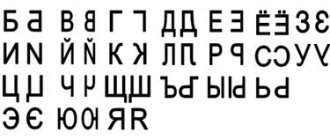Emphasizing the importance of words, we pronounce them slowly, and something secondary and insignificant - as if in a “patter.” However, there are speech pathologies in which the pronunciation of words is so accelerated or slow that the understanding of speech is lost - it is so illegible. These are signs of speech pathology - disturbances in the tempo and rhythm of speech. An adult and a child with such a pathology, seeing how others react to his speech, tries to speak out less so as not to get into an awkward position. What types of speech tempo and rhythm disorders are there? How to diagnose such disorders? How to work with such children in a regular school?
Types of speech rhythm and tempo disorders
Not only a speech therapist, but also parents and teachers can hear that a child’s speech deviates from the normal pace and the rhythm is disturbed, but only a specialist can determine the structure and cause of the defect.
Violations of the tempo and rhythm of speech include:
- Tahilalia is the accelerated pronunciation of words, sounds, syllables at a speed of 20-30 sounds per second (instead of 9-14 normally). The rapidity of speech negatively affects the articulation of sounds. Pathology occurs in childhood, becomes established during adolescence, and can remain with a person for life.
- Bradylalia is a pathologically slow speech, most often found in children with mental retardation or mental retardation, since violations of basic mental processes (memory, attention, thinking) and fine motor skills are often observed in parallel with bradylalia.
- Stumbling - against the background of accelerated speech, repetition of words, syllables and sounds occurs. It must be distinguished from stuttering, since stumbling does not have convulsions of the speech apparatus in its etiology; a child or adult with stumbling does not experience fear of speaking.
- Stuttering - during a statement, involuntary stops occur that are beyond the control of the stutterer. They are accompanied by convulsions of all parts of the speech apparatus.
Treatment of arrhythmia
Should arrhythmia be treated? Some of the disorders, such as single supraventricular or ventricular extrasystoles in the absence of organic heart damage, are harmless and do not require treatment. In other cases, a person’s life depends on timely recognition and assistance.
Treatment of rhythm disturbances depends on the etiology, type of disorder, patient’s condition, and the presence of contraindications for certain methods of influence.
There are several approaches to treatment:
- impact on the cause;
- influence on factors that provoke arrhythmia;
- effect on the mechanisms of arrhythmogenesis;
- impact on patient tolerance to arrhythmia
All therapeutic effects for rhythm disturbances are divided into medicinal
and
non-medicinal
. The selection of pharmaceuticals is always carried out by a doctor and should be monitored by repeated ECG recordings. Based on the approach to treatment, medications of different directions of action are used; antiarrhythmics often come to the rescue. Amiodarone, sotalol, propafenone, verapamil, etc. show high effectiveness.
Non-drug
the direction includes electrical methods: cardioversion and defibrillation, temporary and permanent electrical stimulation; radiofrequency destruction of the ectopic focus, surgical treatment of organic heart diseases (developmental anomalies, valve defects), which are the cause of arrhythmia.
It is important to note that diagnosis at all stages and treatment of rhythm disturbances is carried out only by a doctor. Often, with questioning and an objective examination of the patient (palpation of the pulse, auscultation of the heart), it is possible to suspect the nature of the arrhythmia, and additional studies make it possible to clarify the diagnosis, the cause of the disease and select the correct treatment.
If you feel symptoms
heart rhythm disturbances or are not receiving proper treatment for an already established diagnosis, cardiologists at AVENU medical centers will help solve the problem. You can sign up for a consultation on the website avenumed.ru and by calling the branch nearest to you.
Symptoms of speech tempo and rhythm disorders
With tachylalia (accelerated speech rate), the rapid flow of utterance stuns the interlocutor, whom the speaker practically does not listen to the end of, and often interrupts. The articulatory apparatus does not have time to clearly pronounce sounds, syllables and words; the entire utterance is pronounced in one exhalation, without respite. Tachylalia may be accompanied by twitching of the body or separately of the arms and legs, and grimacing.
Stumbling is distinguished, in addition to the frequent repetition of speech units, by unjustified pauses in speech, stops in the middle of a speech utterance. Unlike stuttering when stumbling, a child’s speech does not deteriorate in front of an unfamiliar audience and does not have periodicity.
With bradylalia , the articulation of sounds is sluggish and unclear, vowel sounds are pronounced stretched out. The voice is monotonous, the statements are not emotionally colored, they lack characteristic modulations. Speech is so slow that it causes impatience and irritation among others.
Children, seeing such an attitude, try to remain silent more often than to speak. This position further retards their mental development. According to scientific research, with bradylalia, not only external, but also internal speech has a slow pace.
Stuttering has a wide clinical picture. It is characterized by the following symptoms:
- Convulsions of all parts of the articulatory apparatus.
- Accompanying movements of the muscles of the face, neck, arms and legs - squinting, stomping, clenching fists, frequent blinking.
- Speech tricks - all kinds of “uh”, “well”. “so”, “here”, etc.
- Fear of speech, fear of pronouncing individual sounds and words.
- Increased stuttering when communicating with unfamiliar people.
Classification of cortical dysarthria in children
Depending on the location of the pathological focus and the mechanism of development, two types of pathology are distinguished:
- Cortical kinetic dysarthria (efferent) is associated with damage to the central zone of the anterior cortex. Due to the proximity of the area that controls hand movements, hemiparesis may occur. Characterized by slowness of speech and lack of rhythm. Some children speak in syllables;
- Kinesthetic (afferent) dysarthria is associated with damage to the postcentral zones. It is characterized by discoordinated work of the organs of articulation and movements of the muscles of the hand on the opposite side.
Based on severity, there are 4 forms of the defect. In the first degree there is no clear clinical picture, then their severity increases. Grade 4 may be accompanied by complete anarthria, that is, lack of speech.
Mixed variants of the disease are possible, for example, cortical-subcortical dysarthria, when in addition to the cortical part, the subcortical parts of the brain are also affected.
Examination of children with violations of the tempo and rhythm of speech
If parents suspect that their child has disturbances in the tempo and rhythm of speech, they should consult with a speech therapist at a children's clinic, speech center, school or kindergarten. Sometimes you can hear the erroneous opinion that you should not start correcting speech deficiencies until the child is 5 years old.
This is partly true for uncomplicated cases of sound pronunciation formation, since the speech apparatus has not yet been formed, and sounds can appear on their own. In all other cases, the sooner correction work begins, the more successful it will be.
At the initial visit, the specialist is required to conduct a speech therapy examination. The main directions of this survey:
- Establishing the cause and nature of speech impairment.
- Determining the rate of speech of the child and his parents.
- Diagnosis of basic mental processes (memory, attention, thinking).
- Studying the history of speech development - the appearance of the first words, phrases, the likelihood of parents forcing the child’s speech. Bilingualism in the family.
- Determining the style of family education, attitude towards the child, the presence of conflicts, difficult life situations.
- Collecting anamnesis of the disorder and concomitant pathologies.
- Determination of existing articulation deficiencies.
- Correspondence of the level of speech development of the child to the age norm.
Perhaps some questions may seem unnecessary to parents, but the speech therapist does not ask them out of idle curiosity - there are no trifles in the development and correction of speech disorders, the situation in the family and the presence of psychological problems are very important.
Speech Disorder Specialists
Speech therapist.
Most speech disorders are a speech therapy problem, which is why speech therapists should be contacted first.
Neurologist
provides medication support to children with cerebral palsy, alalia, dysarthria, etc.
A defectologist is able to significantly “pump up” a child’s brain, develop intelligence and thinking.
An otorhinolaryngologist determines pathologies of the peripheral speech apparatus of a medical nature: hearing loss, cleft palate, adenoid growths, sore throat, etc.
A teacher of the deaf is involved in the development of speech in deaf and hard of hearing children and adults.
Psychologist. Due to shyness or aggressive behavior, the child’s speech is distorted and impoverished. Problems in the family and with peers can cause delayed speech development.
Neuropsychologist (clinical psychologist) - in case of speech disorders (caused by impaired brain function), teaches the child’s brain to function correctly through motor and play exercises.
| Defectology and speech therapy, as well as Neurology services are available in our center. |
Causes of speech pathologies
The basis for disturbances in the tempo and rhythm of speech is an incorrect relationship between the processes of excitation and inhibition in the cerebral cortex.
The causes of tachylalia (accelerated speech rate) are:
- The predominance of excitation processes in the cerebral cortex, responsible for the formation of speech.
- Heredity, congenital characteristics of temperament.
- Imitating the fast-talking of others, mistakes in education - such speech is most often found in unbalanced and excitable children.
The causes of bradyllalia (slow speech) can be:
- Dominance of inhibition over excitation in the speech areas of the cerebral cortex.
- This feature of external and internal speech can be inherited.
- Pathology appears as a result of a child’s imitation of incorrect speech patterns from others.
Causes of stuttering can be:
- Unbearable speech load (learning large poems, memorizing texts that are not age appropriate, memorizing difficult and obscure words).
- Frequent punishment of children, sudden and severe fear, mental trauma due to improper upbringing.
- Excessively accelerated speech due to imitation of family members, getting stuck on individual sounds during speech;
- Traumatic brain injuries, neuroinfections.
The main factors provoking pathology of speech development are congenital or acquired weakness of the nervous system and a decrease in its stability.
Diagnosis of arrhythmia
Doctors have several methods for detecting arrhythmias, and each has its own characteristics.
- ECG
is a publicly available method that provides information about the patient’s rhythm at a given moment in time, allows you to record permanent disturbances and transient ones, if they are present at the time of registration. - Holter monitoring
ECG - 24-hour recording of an electrocardiogram. With this method, it is possible to establish all disturbances in the functioning of the heart within a day. - EchoCG
is an ultrasound examination of the heart. Makes it possible to visually determine the presence of arrhythmia and identify the organic cause of its occurrence. - Provocative tests
: orthostatic test, transesophageal electrophysiological study, intracardiac ECG recording) are capable of artificially inducing and recording arrhythmia when it cannot be detected during daily monitoring due to its transient nature.
What should parents do if their child has a speech disorder?
You should not try to correct this pathology through prohibitions and shouts like “Come on, stop making faces, speak correctly now.” Since these disorders are closely related to the state of the nervous system, you should try to create a calm atmosphere in the family, try to adjust communication with the child, and establish a trusting relationship.
Correction of speech disorders should be carried out by a qualified speech therapist. It is advisable to consult with a neurologist, psychotherapist, or psychologist who works with children with developmental disabilities before starting classes. You will have to be prepared for the fact that the cycle of correctional classes will be long - several months, perhaps several years.
If there are people in the family with speech impairments, you need to work on correcting it. It is advisable for the child to hear calm, quiet speech around him at a leisurely pace for imitation. It is necessary to celebrate any, even the smallest, successes of the child, convince him that the defect can be overcome, and encourage him.
To strengthen the child’s nervous system, it is advisable to carry out general strengthening measures:
- Hardening.
- Doing feasible sports.
- Taking vitamin complexes, a large amount of fresh vegetables and fruits in the diet.
- Maintaining a daily routine.
- Optimization of teaching load.
- As recommended by your doctor, take antipsychotics.
Compliance with such recommendations will lead to the correction of speech disorders.
Treatment of cortical dysarthria in children
Correction of cortical dysarthria begins with pathogenetic treatment of the disease that led to a speech defect. Without this step, no amount of speech therapy help will help restore speech.
Complex treatment includes:
- drug therapy aimed at stimulating metabolism in the brain and restoring its functions. Prescribe nootropic drugs, vitamins, metabolites. In difficult cases, sedatives, tranquilizers, and antidepressants may be needed;
- speech therapy correction of cortical dysarthria - speech therapy massage, articulation gymnastics, development of fine motor skills of the hands, production of sounds. If necessary, a psychologist is involved in the treatment process;
- physiotherapeutic procedures, reflexology, massage, physical therapy help eliminate muscle paresis and improve blood flow throughout the body;
- Relaxation techniques - art therapy, aromatherapy, music therapy help relieve stress and improve the emotional background.
Conventional treatment is long-term. Specialists prescribe several courses of therapy, during which they can adjust the program taking into account the body’s response to therapeutic measures.
How to work with children with speech rhythm and tempo disorders in a secondary school?
At the beginning of correctional work to eliminate speech defects, a speech therapist can establish a so-called “silence mode” for a month in order to break the stereotype of incorrect speech. It is necessary that the teacher supports this event, does not force the child to speak out, and if necessary, then controls that this happens through whispered speech.
It is desirable that speech without hesitation or pauses, practiced in classes with a speech therapist, be encouraged and supported by the teacher. There is no need to force the child to repeat an incorrectly pronounced word, discuss his defect with strangers, or demonstrate the characteristics of the pathology. If such a child is left-handed, you cannot re-teach him to write “like everyone else.” With this approach, speech pathologies will resume with renewed vigor.
It is advisable to protect children with speech impairments from participating in noisy and stressful events, long excursions and travel during their correction. The teacher’s speech should be a role model - clear, smooth, calm, expressive, and impeccable in articulation.
Prognosis and prevention
Timely initiation of therapy using a comprehensive individual approach and the absence of complex neurological pathology are the main conditions for complete speech restoration. The child overcomes his speech impediment and in the future leads a normal life typical for his age. He can study in a regular school and successfully master the school curriculum.
If cerebral palsy or another neurological disease is present, or there is a space-occupying lesion, the prognosis is difficult. In any case, with a competent approach, it is possible to improve speech and reduce the severity of the defect.
Prevention of the cortical form of dysarthria consists of planning pregnancy, giving up bad habits during pregnancy, timely treatment of emerging problems, and preventing complications of pregnancy and childbirth. It is important to choose a method of delivery in advance to prevent birth injuries.







